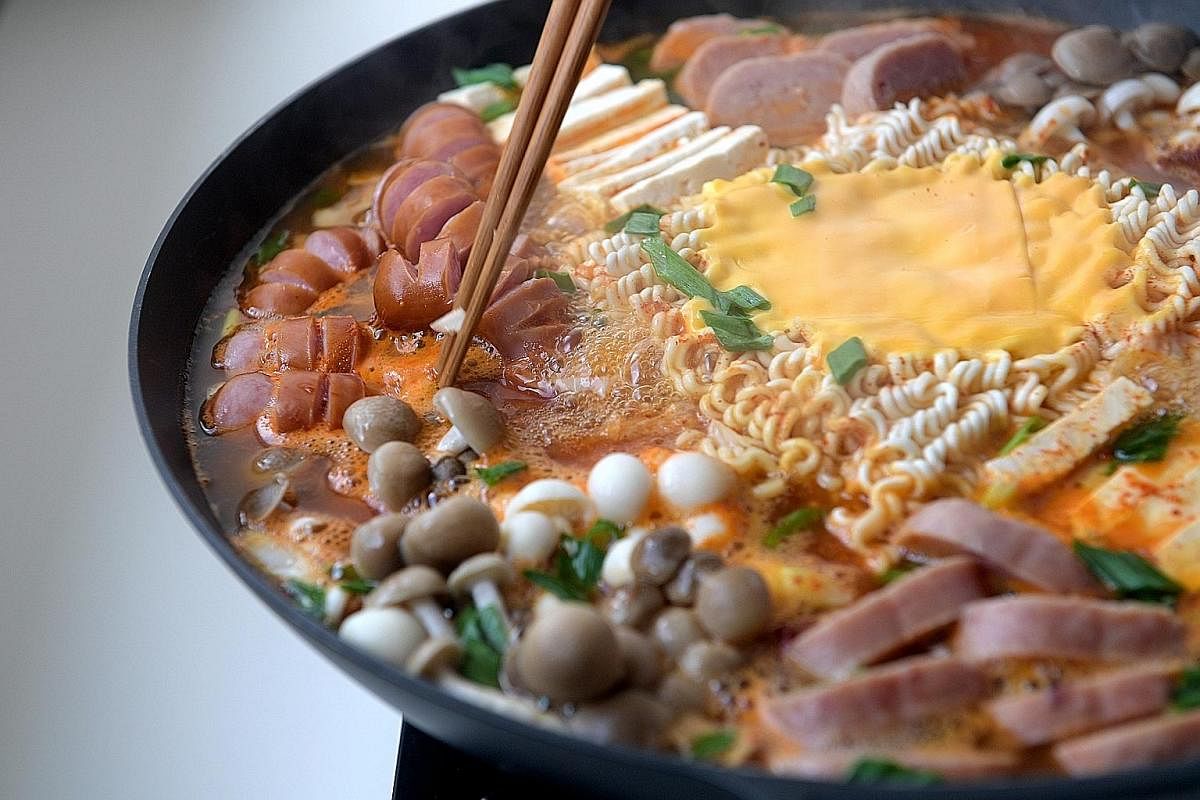What, I often try to recall, was life like before smartphones and social media?
Both have become so entrenched in my life. I often mutter "the camera eats first", sort of apologetically when I aim my phone camera at whatever dish is in front of me, and it's up on Instagram or Facebook later, if it's good.
For a few years now, I have also posted pictures of my first meal of the year.
It is important to me to get the year off to a good start, so I think carefully (perhaps obsessively) about what I want to eat first thing on the morning of Jan 1.
This year was ozoni soup, which the Japanese have at the start of the year. Vegetables, toasted mochi and chicken are simmered in clear dashi broth or miso soup, depending on which part of Japan one is from.
Every year, too, I post a photo of the cookbooks I have bought, despite, of course, resolving not to buy another one. There is no more room for them in my home.
Yet, I am trigger-happy on Amazon and Book Depository and my piles grow every year.
Last year's was so high that Instagram chopped off the three or four books at the top of the pile.
In years to come, I will look at these photos and think back on what I was interested in cooking in any given year.
Not all the books I buy are newly published. Amazing but true, some new books escape my notice and I get to them only when I become obsessed about something.
Recently, it has been Korean food.
I don't quite remember how it started but suddenly, I am wanting to make kimchi; banchan, those little dishes that are an integral part of any Korean meal; and looking high and low for Korean perilla leaves and radish. I have had no luck with the latter, so tell me if you know where to get it.
Korean food is hearty and that is a big part of why the cuisine appeals to me. A bubbling pot of jjigae or stew is a good example. Spoon the goodies over hot rice, mush it up and eat. Heaven in a bowl to me.
One of these stews, budae jjigae or Korean army base stew, even has an interesting story.
It came about, like many dishes, because of necessity.
Food was short after the Korean War in the 1950s and enterprising Koreans used canned American army rations such as Spam, sausages and baked beans from the army bases to make a stir-fry with cabbage.
Later, the dish evolved into a stew with fiery gochujang, or Korean chilli paste, and gochucharu, or Korean chilli flakes, added to it.
You do not have to look far for similar stories. Snowy white Japanese cream stew came about post World War II. Powdered milk supplied by the United States was made into sauce for simmered chicken and vegetables served as school lunches to malnourished kids.
The Vietnamese used the baguettes and charcuterie introduced by French colonisers to create banh mi sandwiches, given an Asian flavour with coriander leaves and pickled radish and coriander, plus Vietnamese-style charcuterie.
I have had budae jjigae in Korean restaurants here, but nothing prepared me for how good a homemade version tasted.
On a rainy night recently, I asked friends over for dinner and decided it was perfect budae jjigae weather.
One thing I love about this stew is the flexibility. I cannot bear the thought of canned sausages so I get my favourite ones, smoked bratwursts from Johnsonville. I do not like the idea of baked beans in this stew so I leave it out.
Instead of processed cheese, you can use a thick slice of good cheddar or havarti, a good melting cheese. I just use the processed stuff.
If all these ingredients horrify you, use chicken thigh cut into bite-sized pieces and marinated with soya sauce and sesame oil and thin slices of pork belly or collar marinated with salt and white pepper.
Luncheon meat, however, is non-negotiable, at least to me. I love how it tastes after soaking up the spicy broth in which it has simmered.
To make the dish seem healthy, I add lots of napa cabbage, kimchi, mushrooms and firm tofu.
The seasonings for the stew can be adjusted for taste.
I prefer mild gochucharu, or Korean chilli flakes, to the spicy version, which just catches in my throat and makes me cough. My friends laugh at me. The hotter, the better, for them.
The dish is best enjoyed at the dinner table, with a portable stove in the middle and the stew simmering away.
I hate an overloaded pan, so I use a large one that is 36cm in diameter. If you do not have one that big, use the largest one you have and arrange some of the ingredients on a platter, to add as you and your guests demolish the stew.
Now is the best time to make it, when it is cool and wet. A young colleague who was recently in Seoul on an exchange programme said some restaurants there serve the stew with hot buttered rice. That sounds like a very good idea.
I never thought I would write this about Singapore, but it is time to get warm.
• www.facebook.com/tanhsuehyun
• For a video of Korean army base stew, go to str.sg/hungry
KOREAN ARMY BASE STEW
INGREDIENTS
Spice paste
8 to 10 cloves garlic

25g gochugaru (Korean red chilli flakes, above left)
40 to 50g gochujang (Korean red chilli paste, above right)
2 tsp soya sauce
2 tsp sugar
2 to 4 Tbs chicken stock
Stew
400g napa cabbage
300g firm tofu
300g mushrooms
340g tin of luncheon meat
300 to 400g sausages
3 to 4 stalks scallions
200g kimchi
1 packet Korean instant noodles
2 to 3 slices processed cheese
2 to 3 litres warm chicken stock
METHOD
1. Finely chop the garlic and place in a bowl with the rest of the ingredients for the paste. Mix with a spoon and add more stock if the paste is too stiff. It should slide off a spoon easily. Set aside.
2. Rinse the cabbage, chop off the root part and slice crosswise into 2cm-wide pieces. Rinse the tofu under running water and slice as thinly or thickly as you like. Slice the mushrooms, or if using shimeji, slice off the root end and separate the mushrooms from the clump. Halve the block of luncheon meat and slice into 1cm-thick pieces. Slice the sausages as thinly or thickly as you like. Slice the scallions on the diagonal.
3. In a frying pan or shallow pot (the one I use is 36cm in diameter), begin layering the ingredients. Scatter the napa cabbage at the bottom, followed by the kimchi. Place the instant noodles in the middle. Top with the slices of processed cheese. Arrange the tofu, mushrooms, luncheon meat and sausages around the noodles. Do not overload the pan. If you have ingredients left over, place them on a platter.
4. Dollop the spice paste over the ingredients and scatter the chopped scallions on top.
5. Set the pan on a portable stove at the dining table. Pour in enough warm chicken stock to reach two-thirds of the way up the sides. Turn the heat on to medium.
6. The stew is ready to eat when the stock bubbles, the instant noodles are cooked and the cheese has melted. Serve with rice, each bowl topped with a pat of butter to be mixed into the rice. If there were ingredients that would not fit in the pan, add them as you eat the stew, and add more stock as needed.
Serves four


